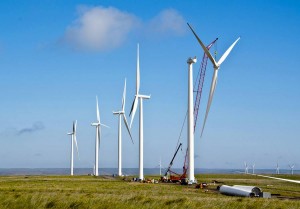by Chester McConnell, Whooping Crane Conservation Association
The U.S. Fish and Wildlife Service (FWS) is considering issuing the first-ever Incidental Take Permit to a wind farm for endangered Whooping Cranes and threatened Piping Plovers. If FWS grants the permit, the Merricourt Wind Power Project in North Dakota would be protected from prosecution under the Endangered Species Act (ESA) for killing Whooping Cranes and Piping Plovers.
Whooping Crane Conservation Association contends that: 1) FWS failed to give the public adequate notice on an important endangered species issue, 2) the agency is only preparing an Environmental Assessment for a precedent-setting take permit of significant environmental impact, and 3) there are fewer than 300 individual Whooping Cranes left in the wild Aransas/Wood Buffalo flock which migrates through North Dakota.
The Merricourt Wind Project proposes to build 100 turbines within a 22,400 acre project area and build 33 miles of access roads. FWS has advised the project developer that the wetland stopover habitat in the project area is critical to the survival and recovery of the Whooping Crane. The site is also about two miles from designated critical habitat for Piping Plovers. In addition, FWS has told the developer that three ESA candidate species may be present at the site (Sprague’s Pipit, Dakota skipper, and Powesheik skipperling).
Whooping Crane Conservation Association president Brian Johns recently wrote a letter to the project manager explaining the Association’s position. President Johns wrote: “The Whooping Crane Conservation Association (WCCA) would like to express our concerns over the placement of the proposed Merricourt Wind Power Project in North Dakota. Wind Power projects have been identified in the International Recovery Plan for the Whooping Crane as a potential threat to flying Whooping Cranes. As you know the Whooping Crane is listed as Critically Endangered by the IUCN as well as both the United States Fish and Wildlife Service and the Canadian Wildlife Service. The Aransas/Wood Buffalo population (AWBP) which contains fewer than 300 individuals is the only self-sustaining wild population of whooping cranes. With such a limited population, the genetic contribution of each individual is critical to the survival of the species.”

The Merricourt Wind Project proposes to build 100 turbines within a 22,400 acre project area and build 33 miles of access roads.
John’s letter continues: “The proposed placement of this wind power project directly within the migration corridor of the AWBP seems like an accident waiting to happen. We understand that the USFWS may grant an Incidental Take Permit, which would allow the project to proceed. The WCCA is opposed to locating any wind power projects within the migration corridor. If such a project were to proceed, we would expect the USFWS to ensure that all mitigation measures listed in the Whooping Crane Wind Development Issue Paper are taken to avoid harm to the AWBP of Whooping Cranes.”

